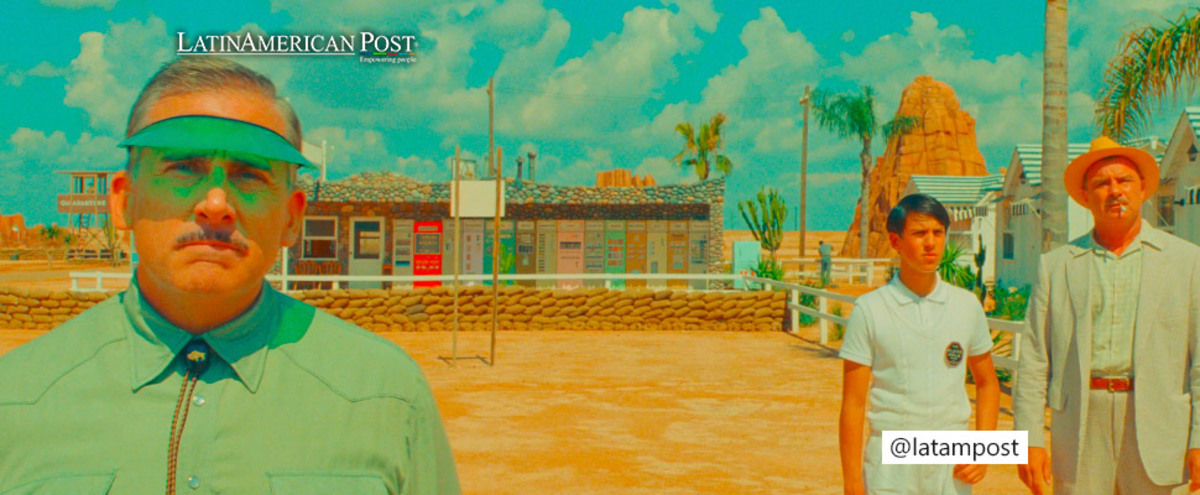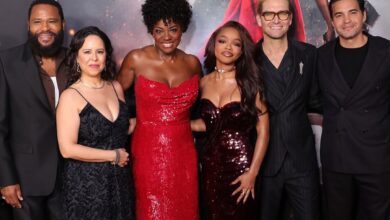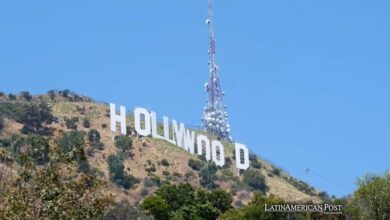“Asteroid City” Review: A Wes Anderson-Style Metafiction Exercise
In his new film, Wes Anderson experiments with metafiction, taking audiences to a desert town where an all-star cast witnesses an event that changes the course of humanity. This is our review of "Asteroid City".

Photo: Focus Features
LatinAmerican Post | Juan Andrés Rodríguez
Listen to this article
Leer en español: Reseña de “Asteroid City”: Un ejercicio de metaficción al estilo de Wes Anderson
Vibrant colors, hand-painted sets, eloquent monologues, symmetry in every shot, changing aspect ratios, and Jason Schwartzman are some of the elements that have distinguished Wes Anderson's works. A style that originated a trend in Tik Tok rejected by the director, considering it a reduction of his work to an exercise in form over substance.
Although this statement is controversial, it denotes Anderson's particularity as one of the emblematic filmmakers of the 21st century and with it a complex situation in which each of his works is inevitably evaluated in comparison to the rest of his filmography, especially how to innovate on its already familiar format.
With “Asteroid City” Anderson bets on a great cast for a story that mixes metafiction with American mythology about 20th century extraterrestrial life. In a retrofuturist version from the 50s, a work is presented about a desert city that, in the middle of an astronomical convention, witnesses an event that will change the course of humanity.
The film reflects on the creation of stories, in art and science, as a mechanism to face death and thereby find the meaning of life. It's an interesting proposal that unfortunately loses focus amid the scale and ambition of the cast for the project, so ironically the result stands out for its relentless execution of the visual as a counterweight to a convulsive and, therefore, superficial narrative.
Anderson made his debut in 1996 with Bottle Rocket, a low-budget independent film that today represents the beginning of a career like no other that over three decades has consolidated one of the most distinguishable original film repertoires in the history of cinema. Attending an Anderson film is discovering or returning, depending on the case, to a comforting place that makes his cinema a game that experiments with colours, textures, and sizes in search of a visual delight that stands out for the curious shapes to represent the loneliness, anguish, violence, and pain faced by its protagonists.
Unlike the magnificence of "The Grand Budapest Hotel" and the eclecticism of "The French Chronicle", "Asteroid City" stands out for minimalism, under Anderson's terms, and from its production design it captures the audience's commitment to the farce that is presented in the tables. Under a blue and clear sky, the silhouettes of these characters stand out who, by the author's pen, have been condemned to confinement in a city of white cabins in the middle of an arid and rocky desert. At the same time, we see the origin of this story in interludes such as black and white memories, distant and confused, that make the "real" world something so melancholic that it makes us want to return to the fantasy of the work.
Anderson is faithful to his codes and seeks to innovate without betraying what the audience knows and expects from him, so it is up to each particular taste to describe the film as "charming" or "a repeat". In any case, the attention to the smallest detail of the staging must be recognized. The same cannot be said of the script, oversaturated with characters to the point of confusion and lack of time to delve into the existential issues it raises. With a spectacular cast that includes Tom Hanks, Maya Hawke and Scarlett Johansson, to name a few, each actor has a moment to shine, but none cements a memorable or distinguishable character in their director's almanac of eccentricities due to a lack of development in their bows.
Read also: "Indiana Jones and the Dial of Destiny": An Acceptable Ending, But Nothing Special
The film's narrative proposal is very interesting, since it links two discourses, that of art and science, to address the mythology of alien life and how those stories that we locate in the stars allow us to explore the questions and anxieties about our existence. The creative process is approached as a search whose answers are not definitive or even clear, which are sometimes limited to the visceral and the approach to the unknown as an excuse for introspection. All framed in the existentialist question of how to face and accept death.
It's clear that there are plenty of ideas that Anderson and his frequent collaborator Roman Coppola want to explore, and this leads to the film's main flaw in lack of focus, resulting in a sparse story that lacks depth, which is very frustrating for the potential with which it starts. At the acting level, they all perfectly meet Anderson's standards. We can highlight Jeffrey Wright's brief monologue, although his work in "The French Chronicle" is more meritorious, and the Faris triplets who play the adorable daughters of Augie Steenbeck (Jason Schwartzman), who star in the most moving moments and deserved to be the center of history.
Although it is interesting that Wes Anderson seeks to innovate within his filmography through an exercise in metafiction, the story he has chosen for this experiment is not very appropriate, especially given the size, metaphorical and real, of the talent involved. Even so, it is a solid work that stands out for its very particular and original style, something essential at a time when "making movies" with artificial intelligence is already being considered, which makes each Anderson film a valuable visit to the theaters.




